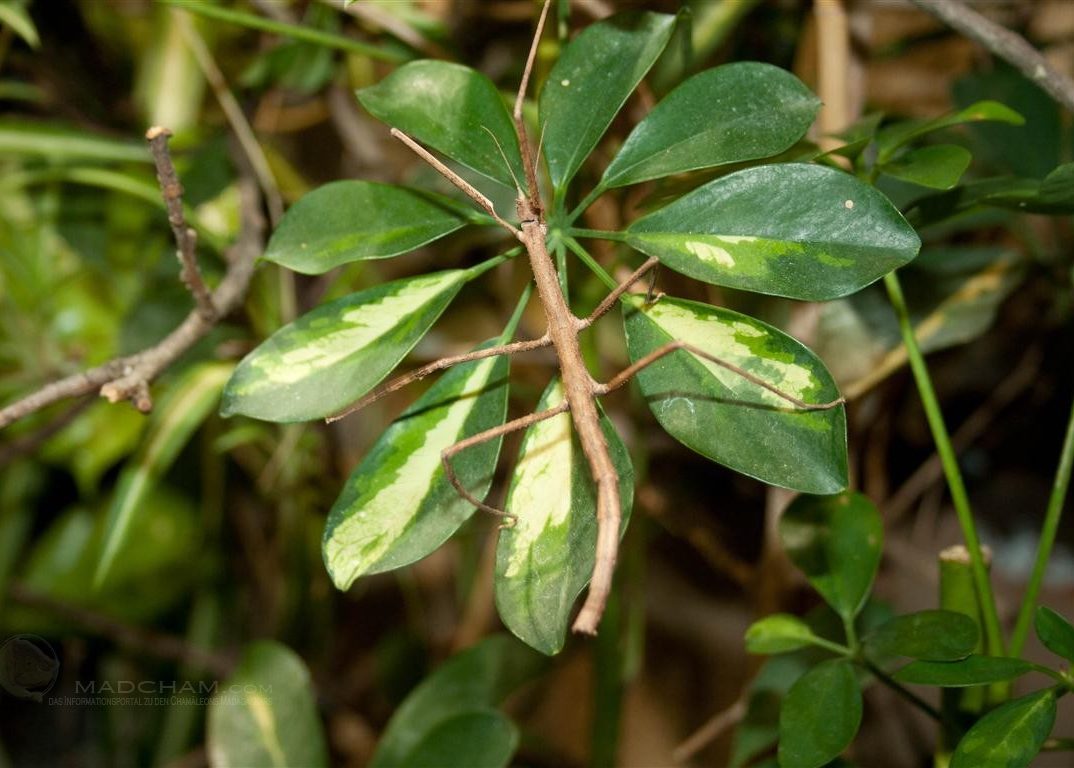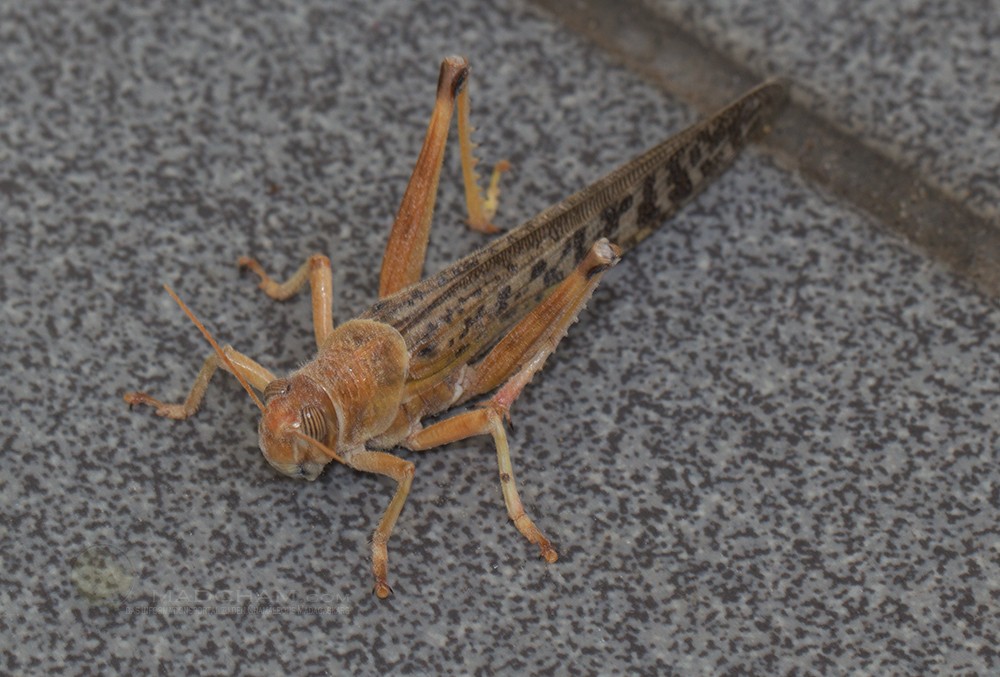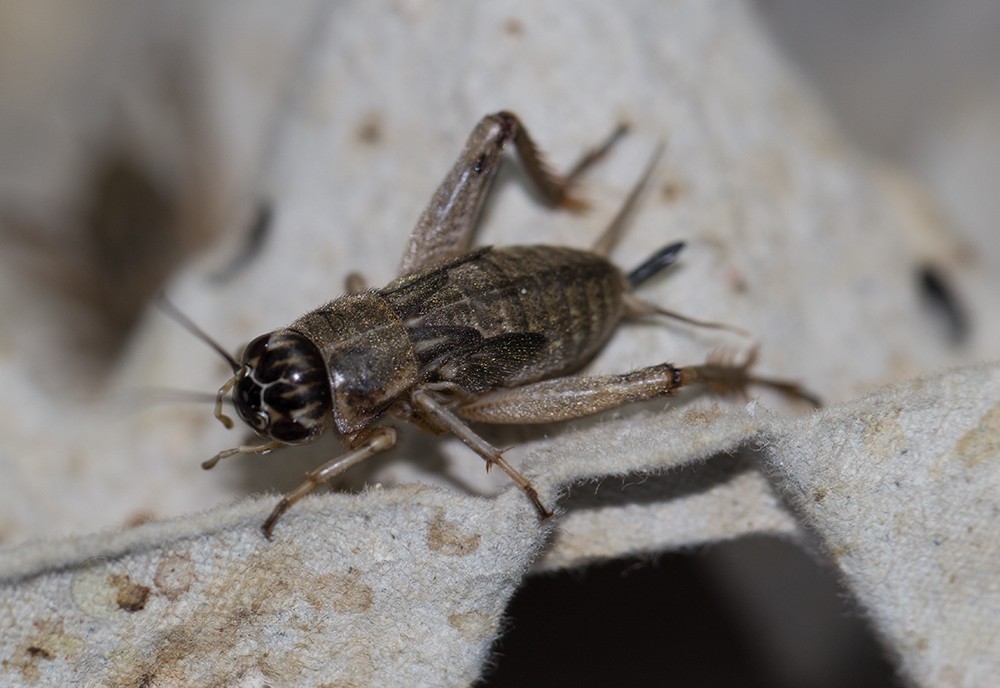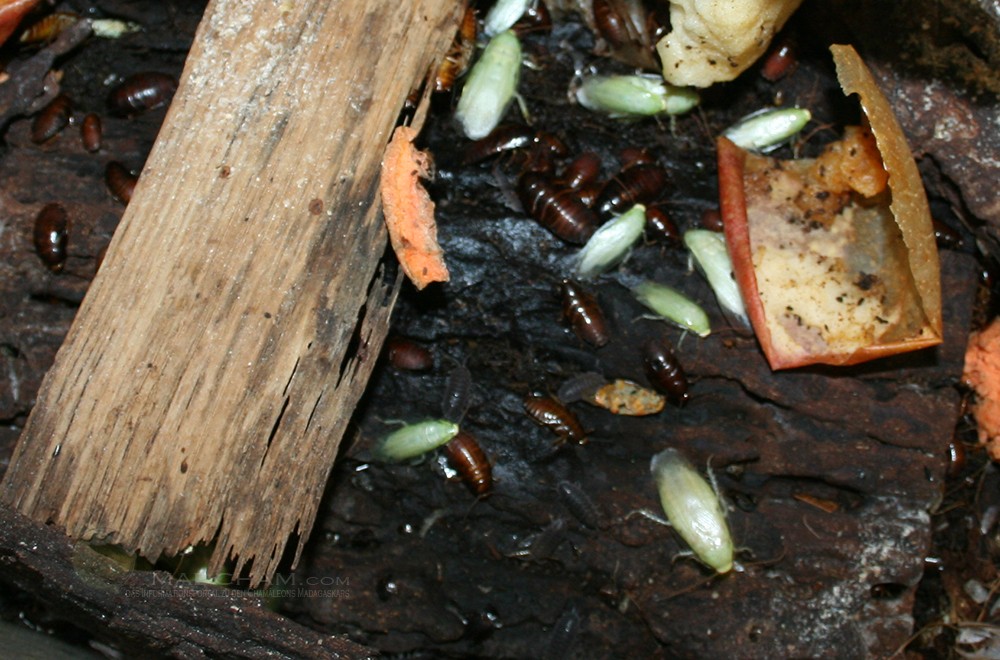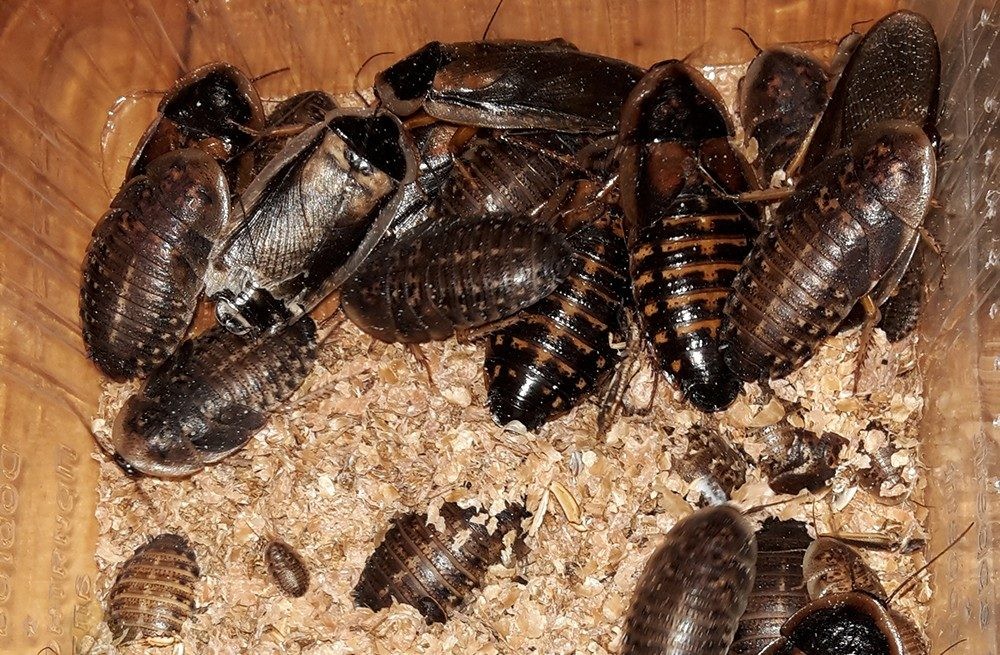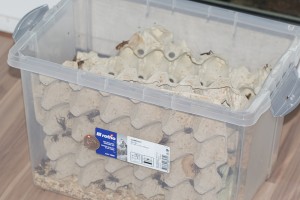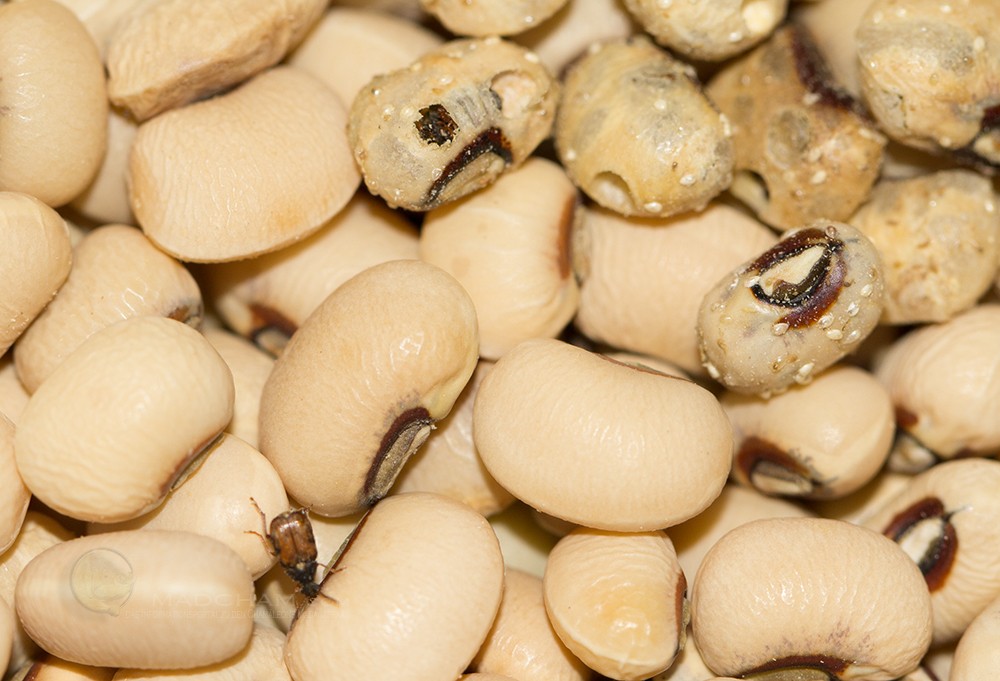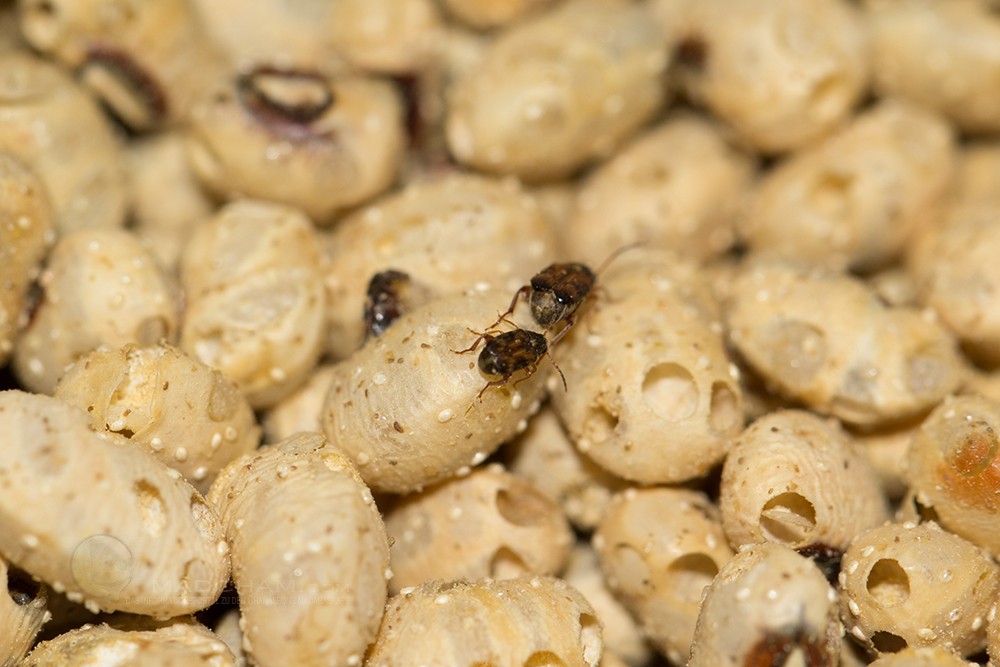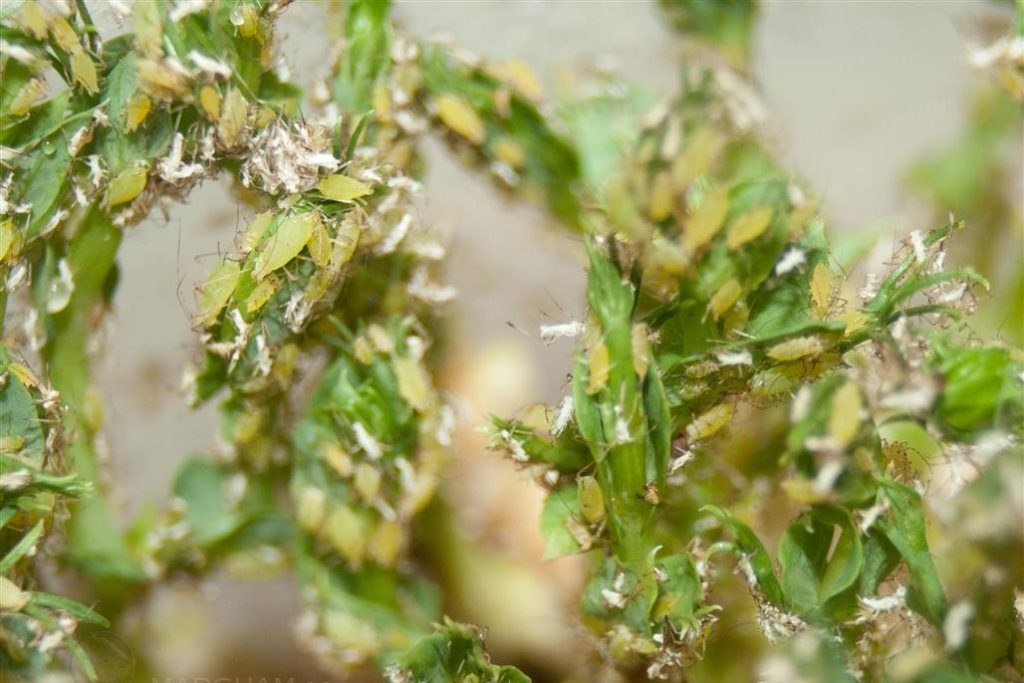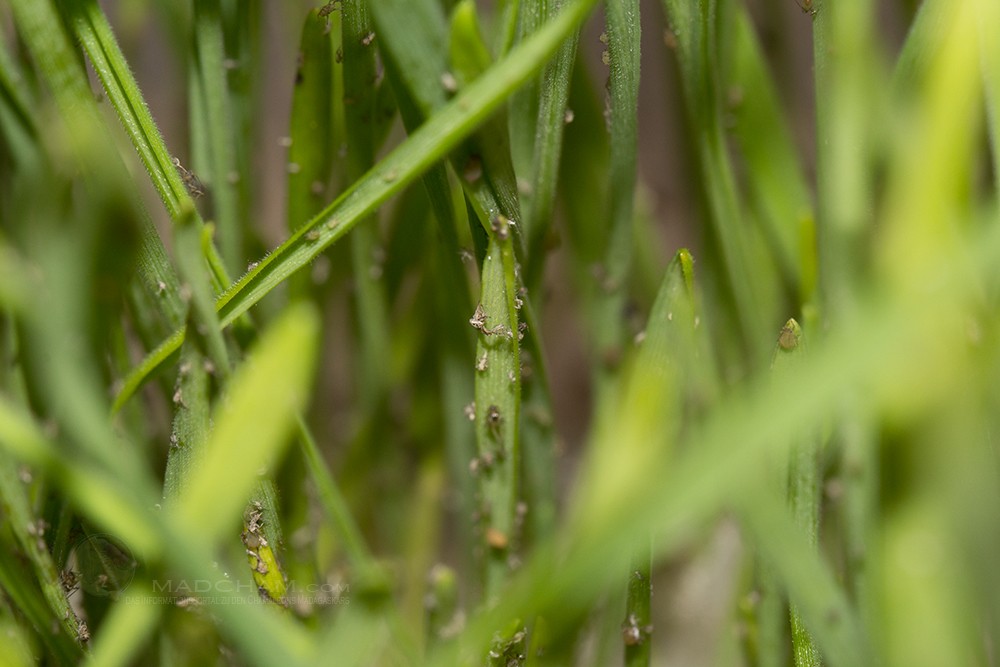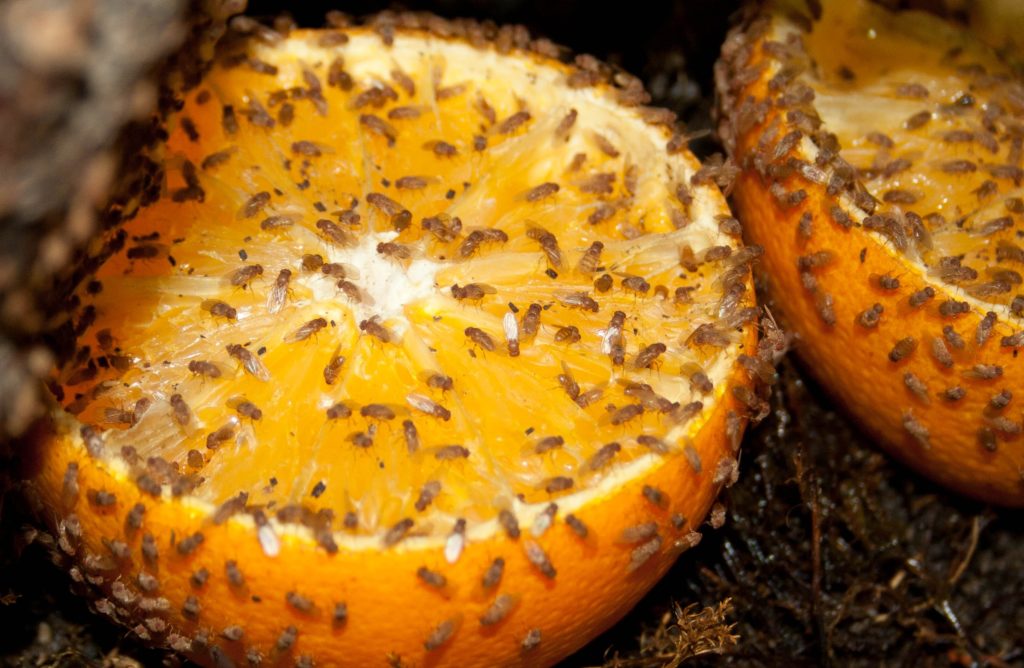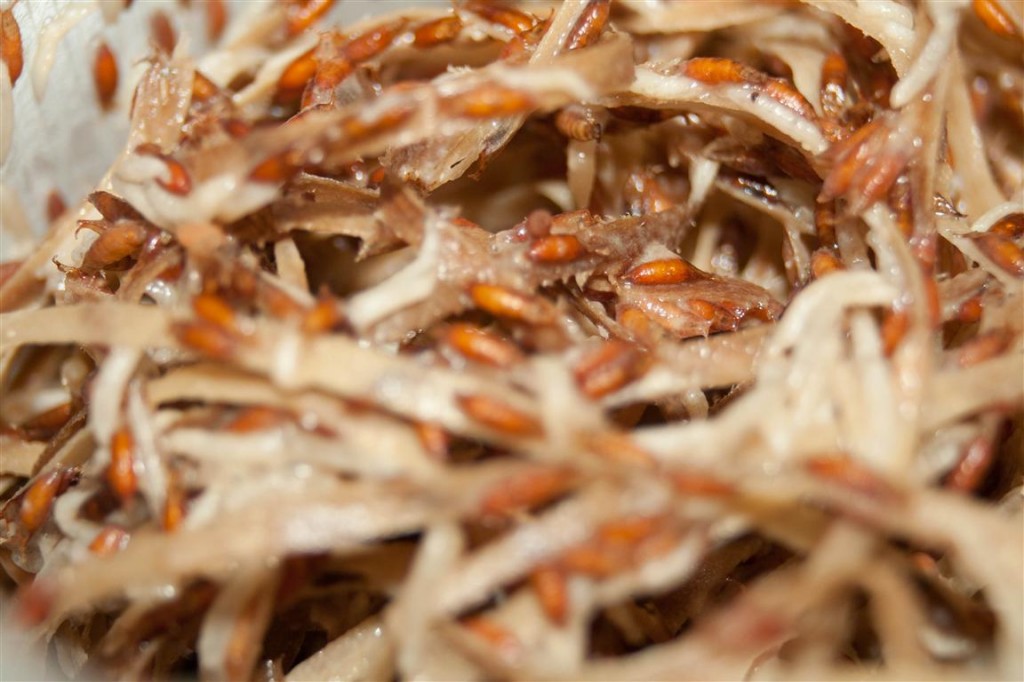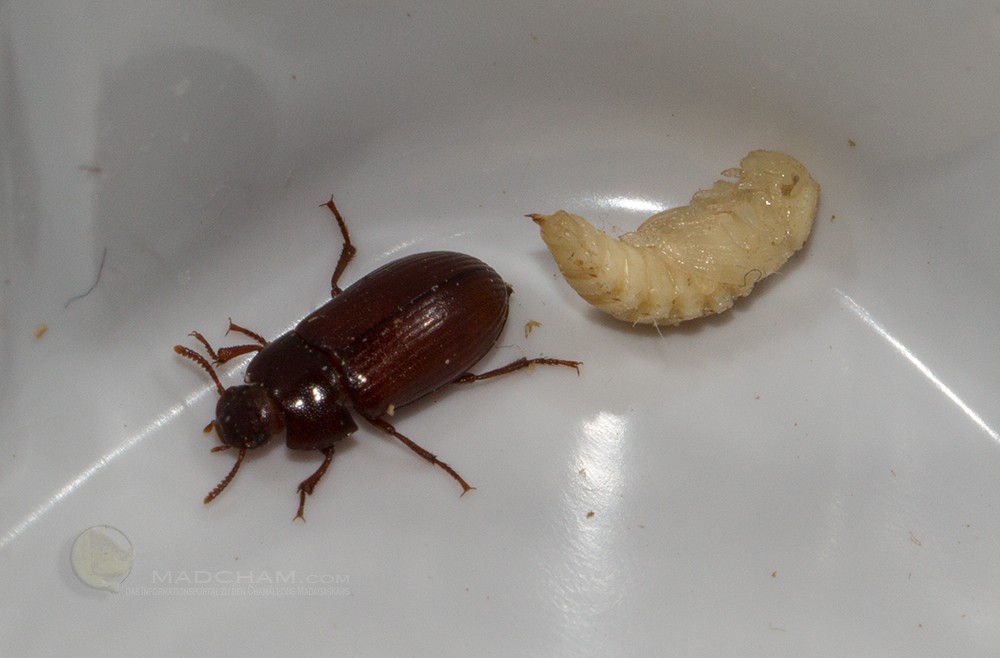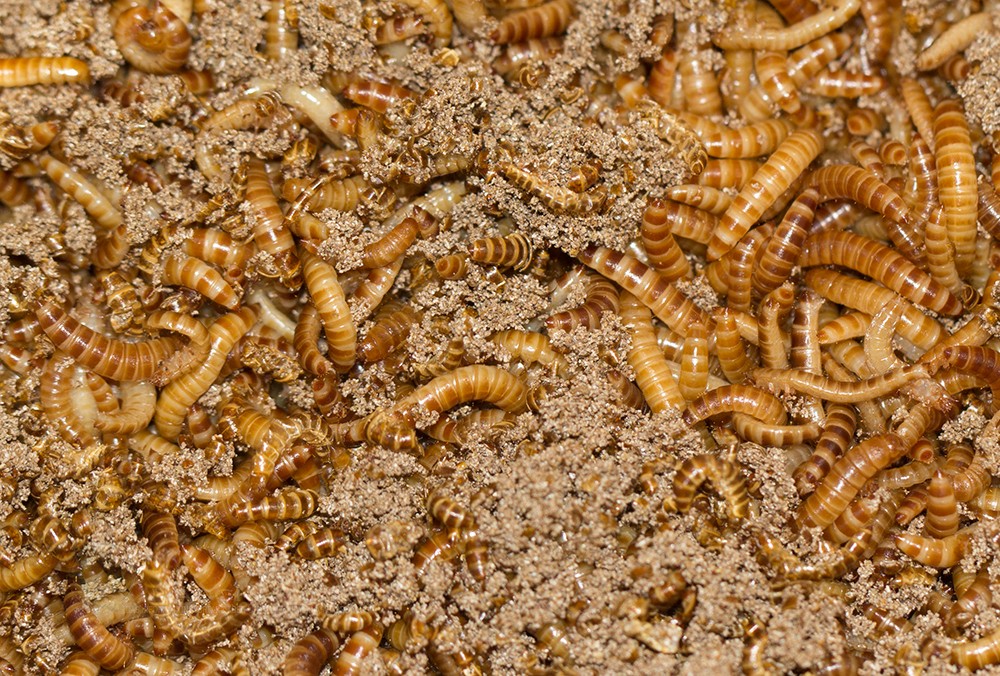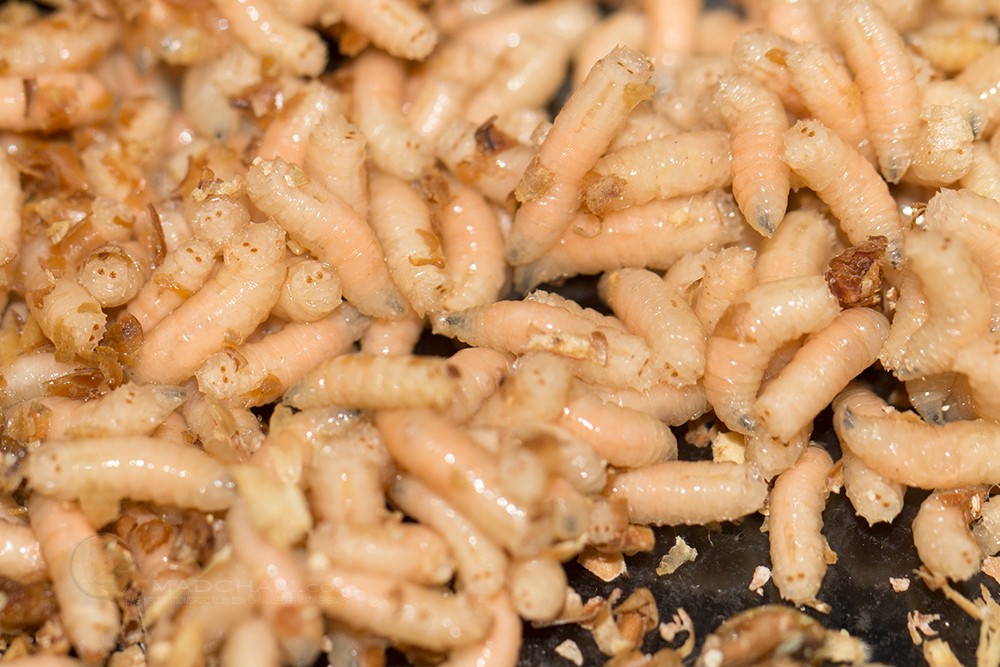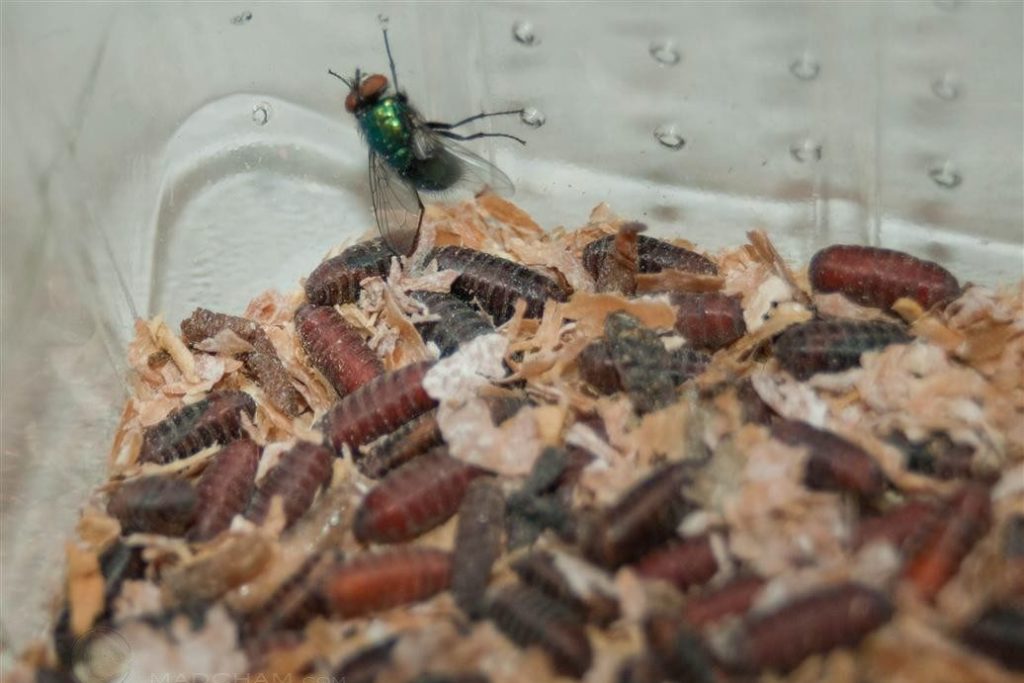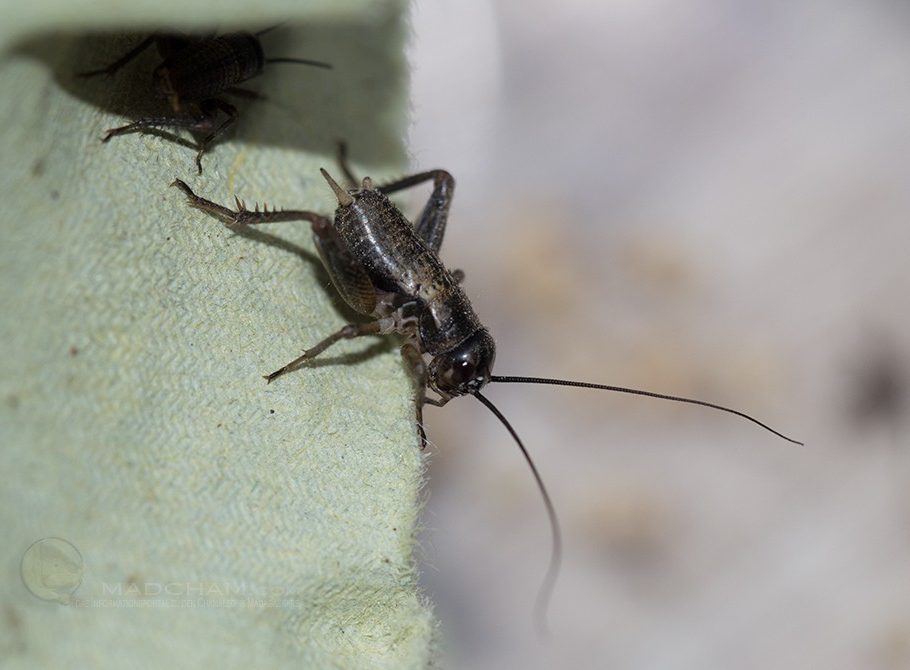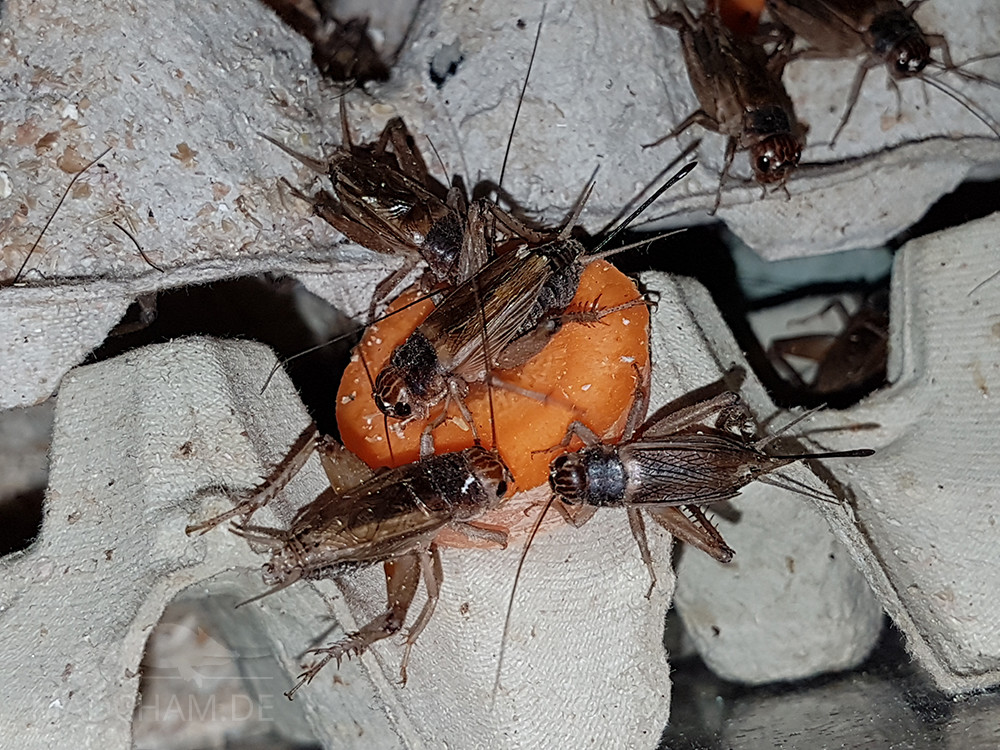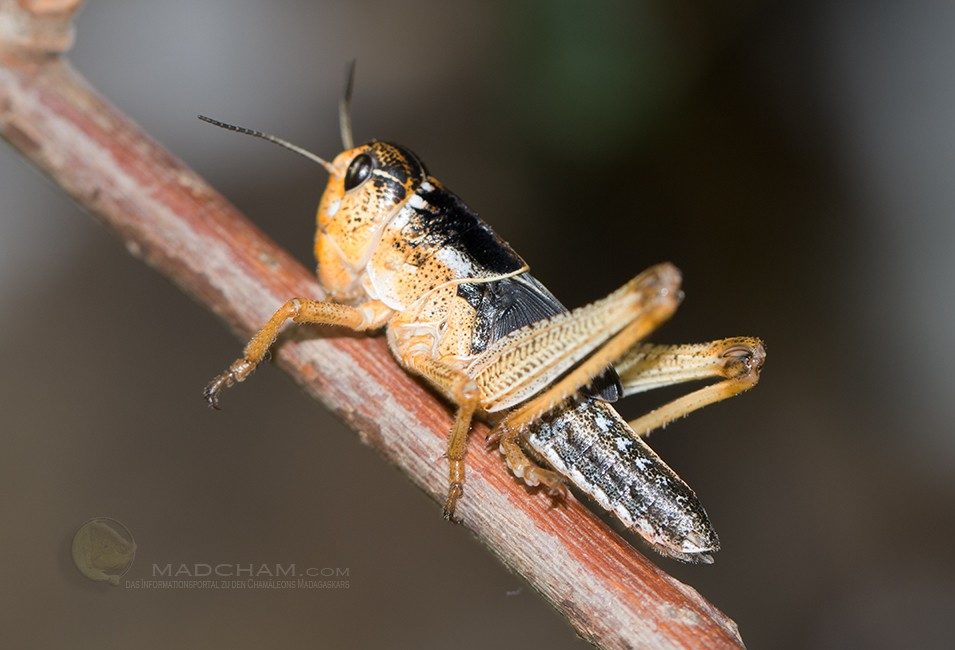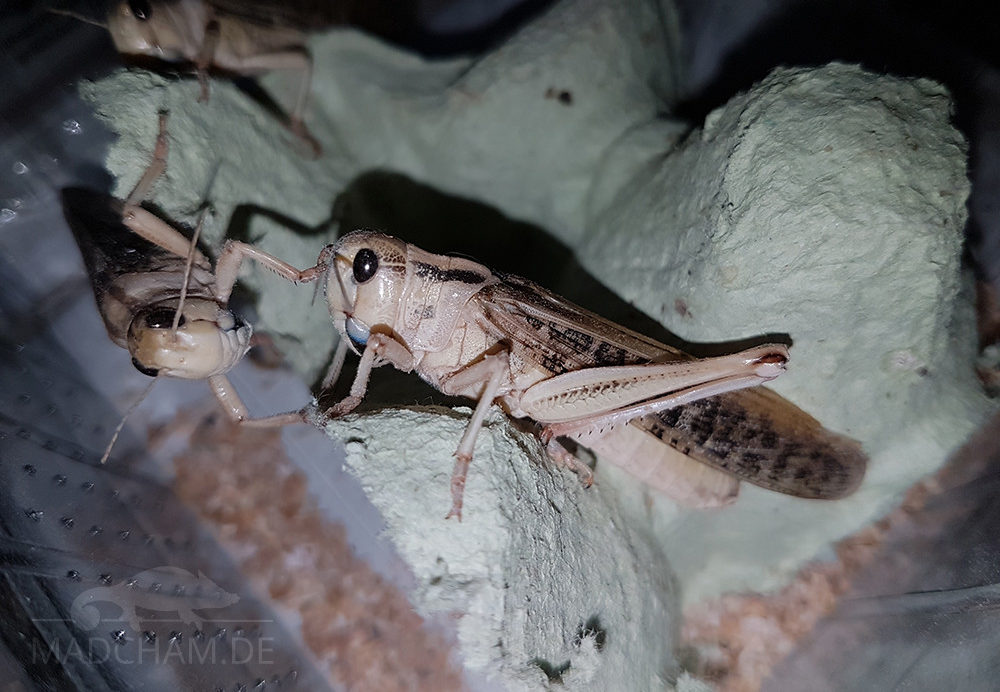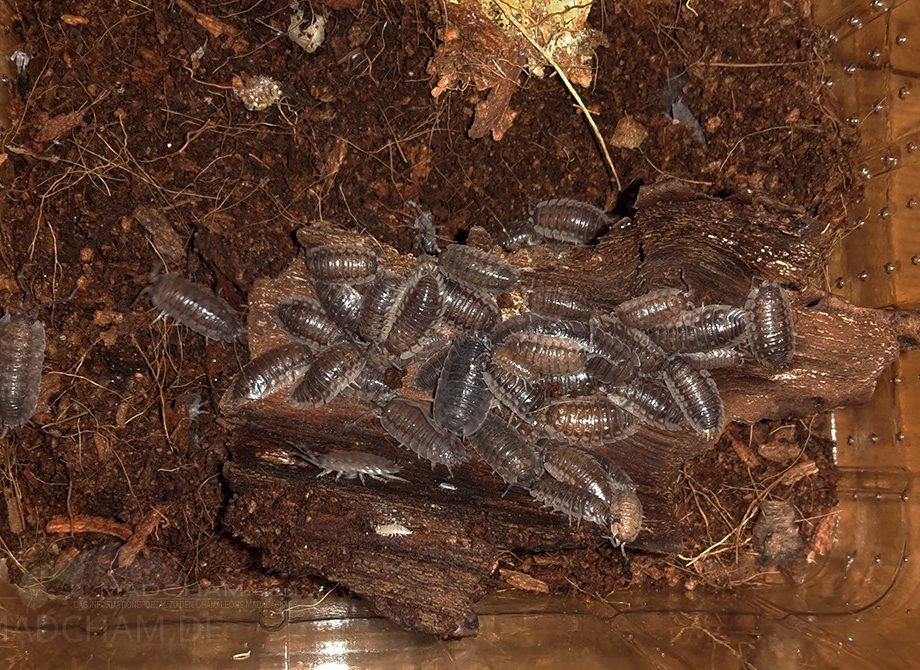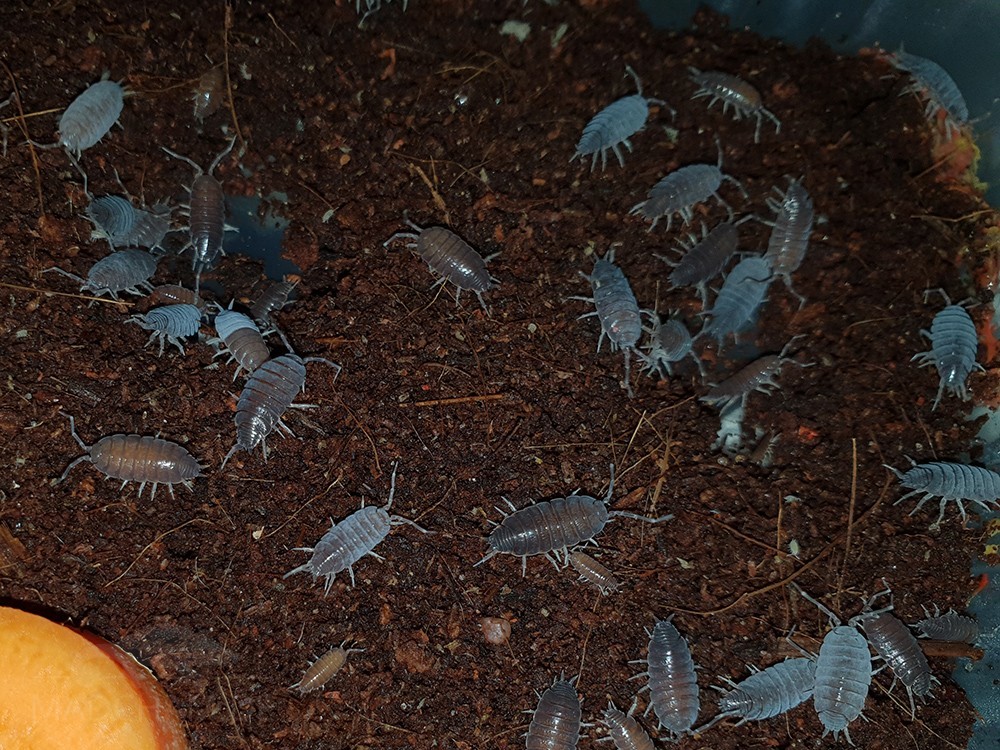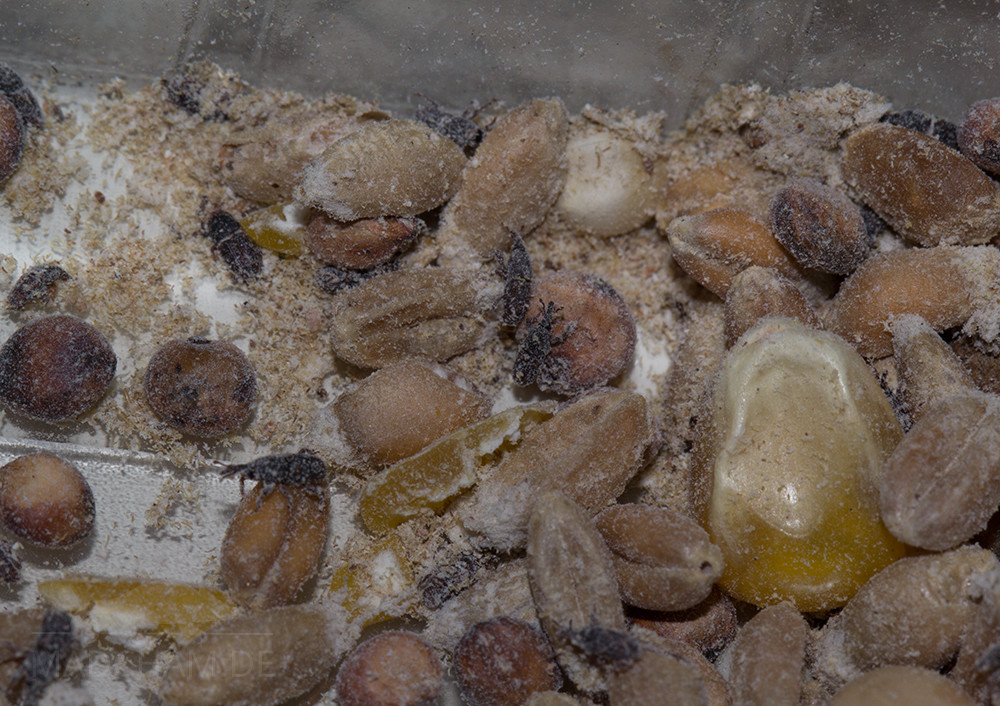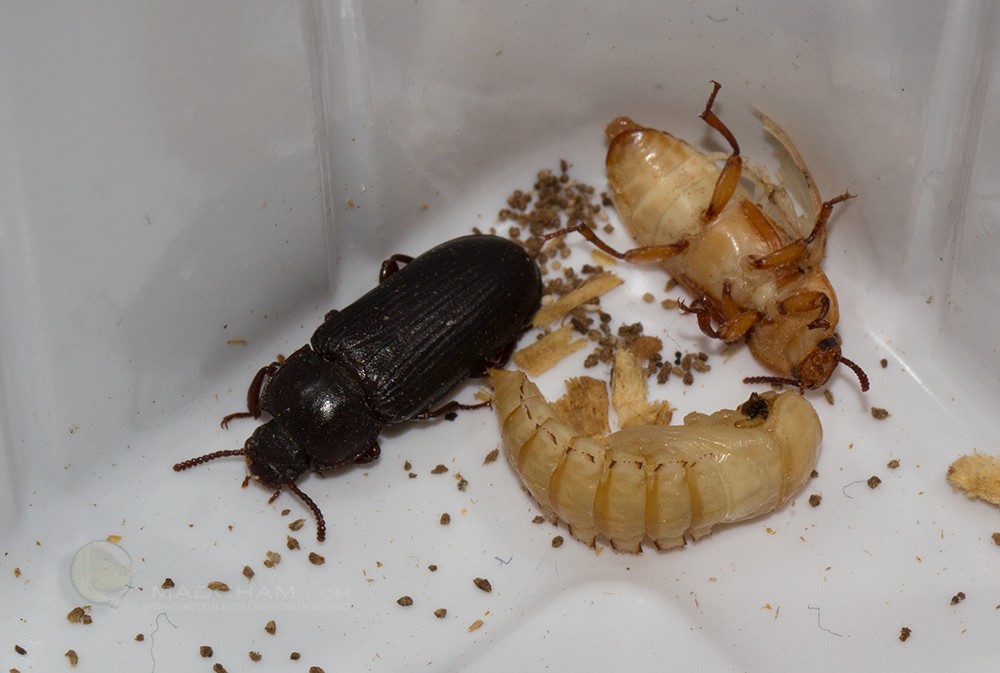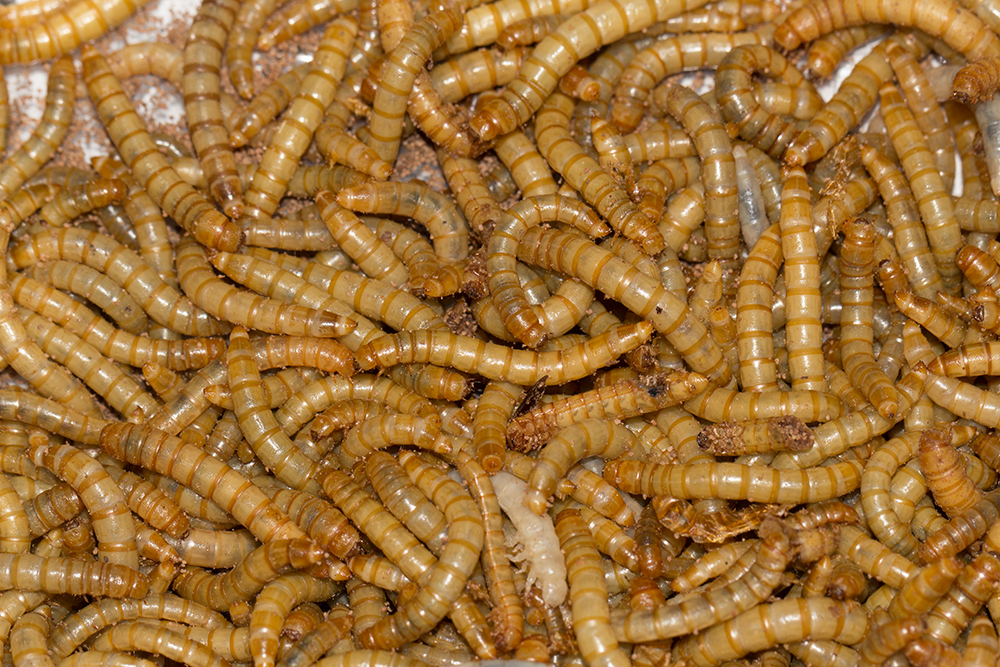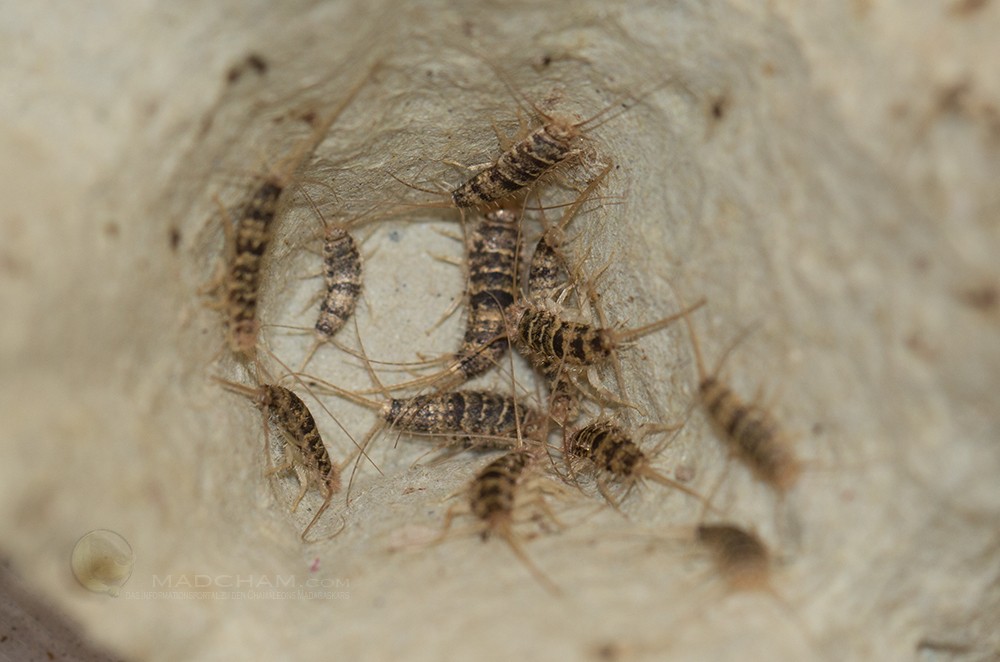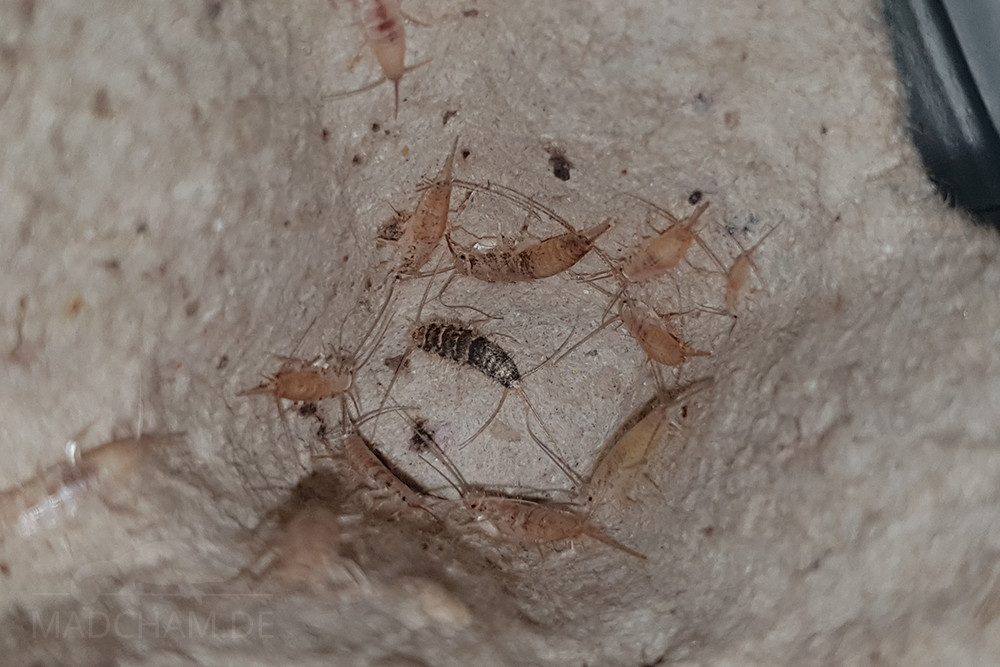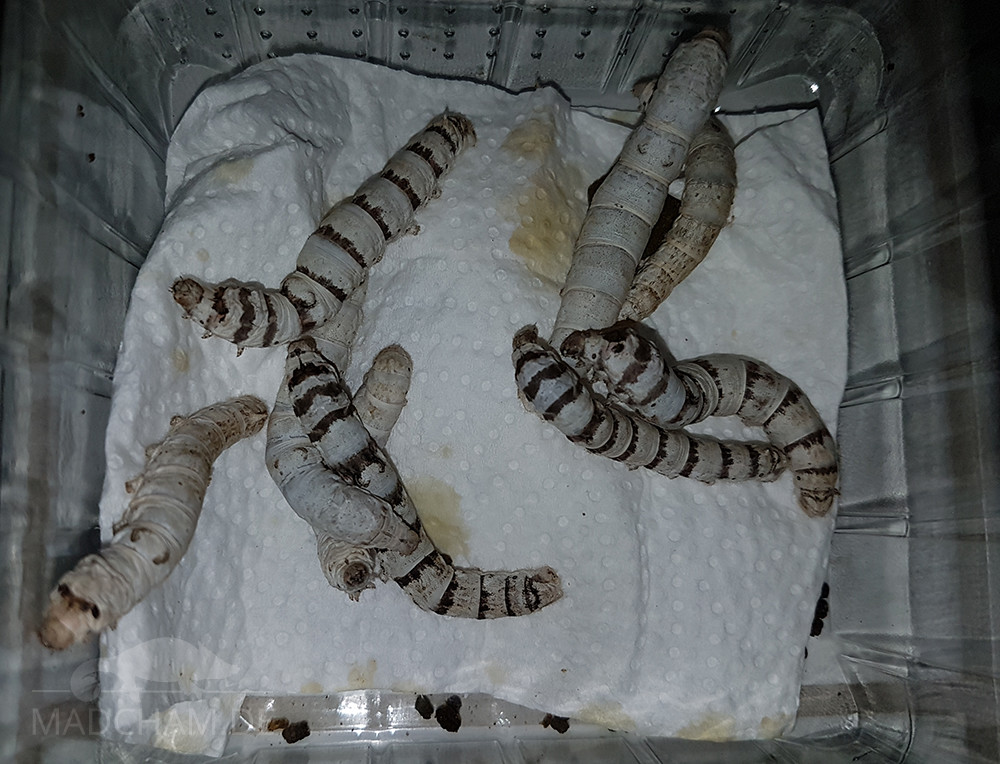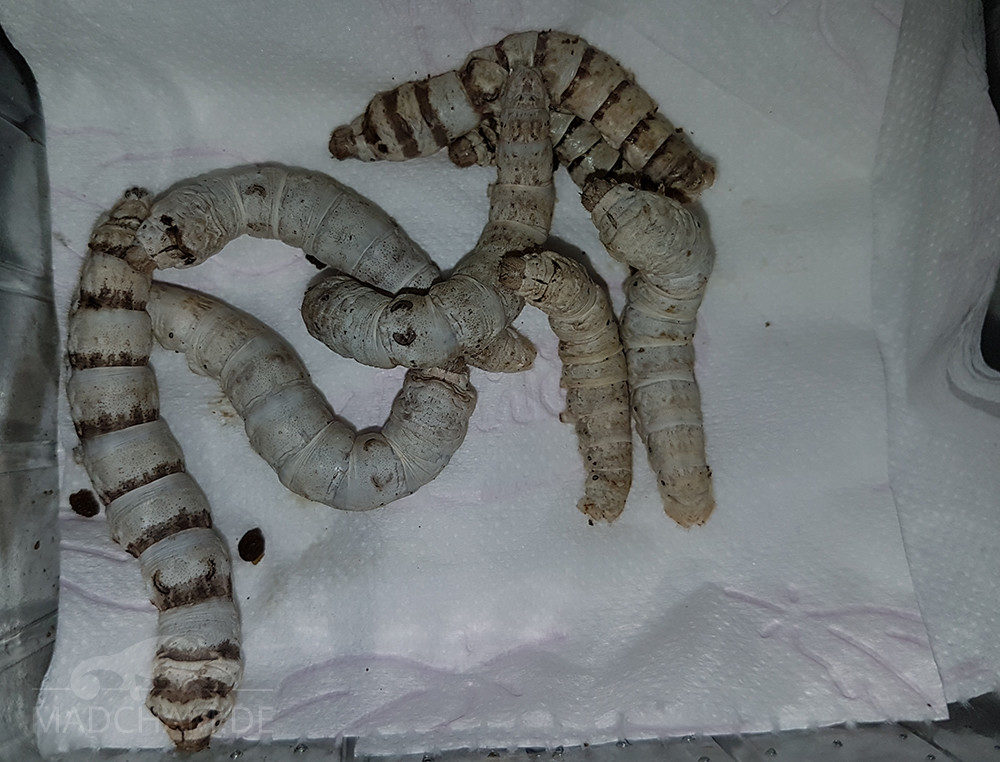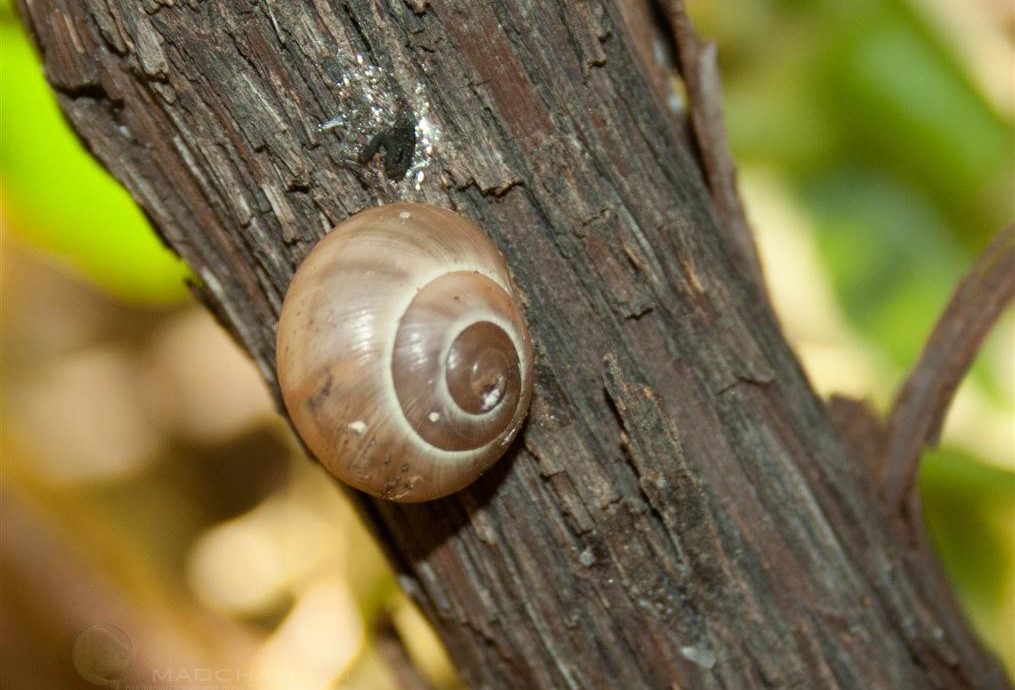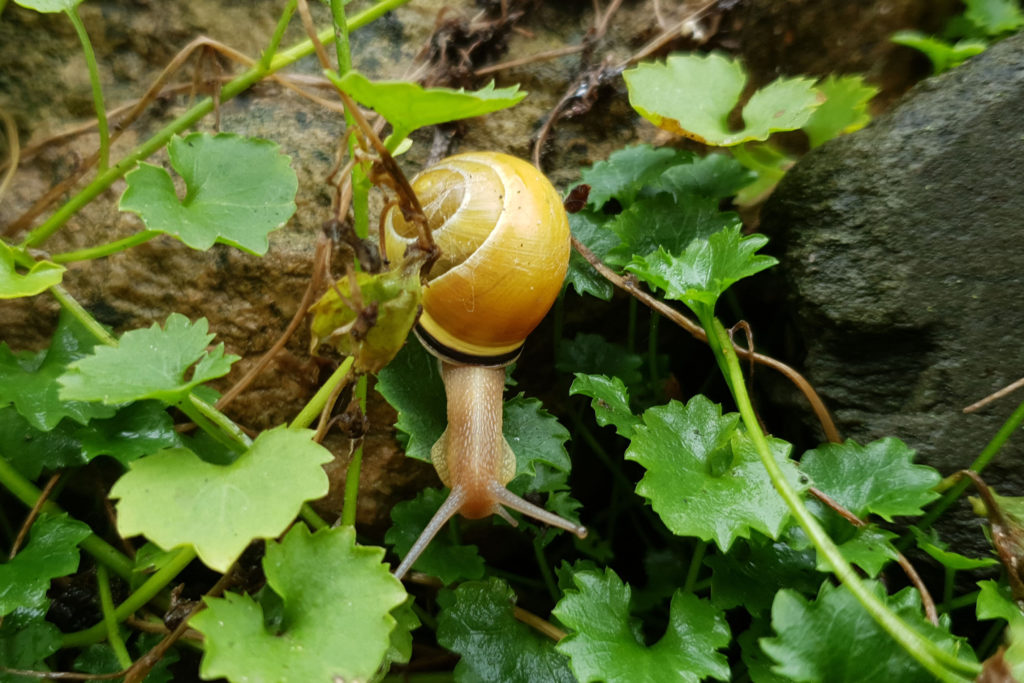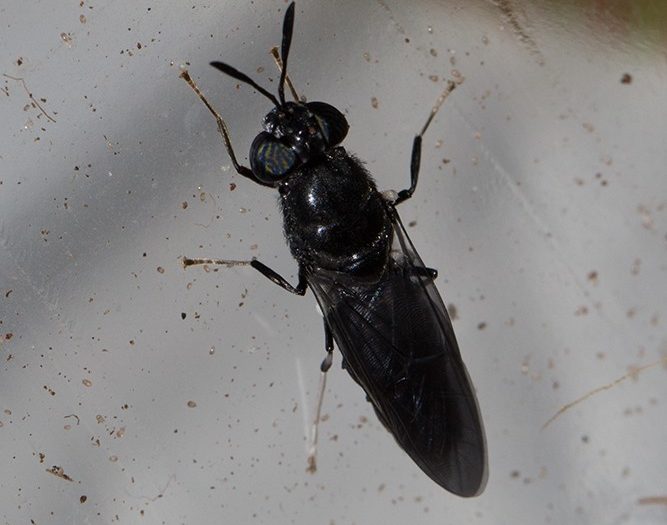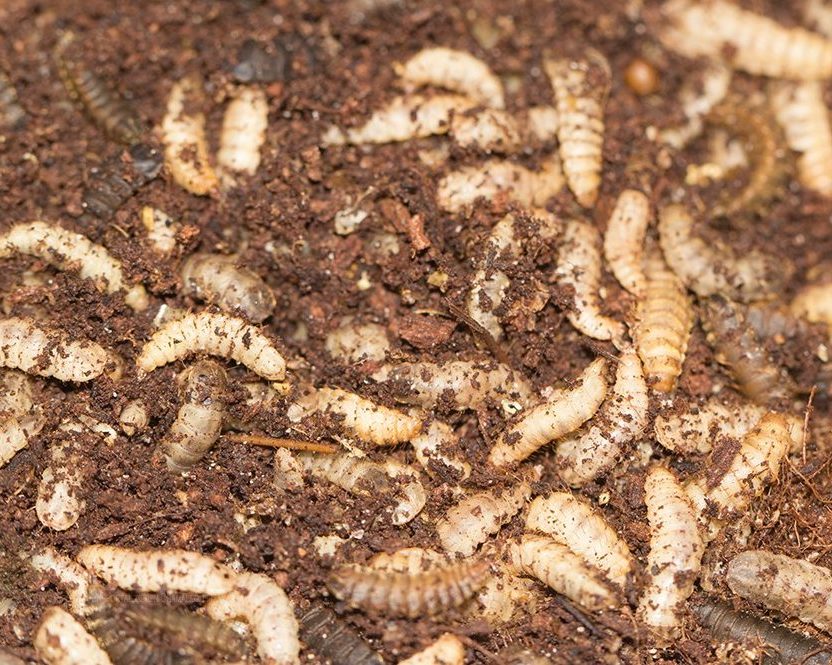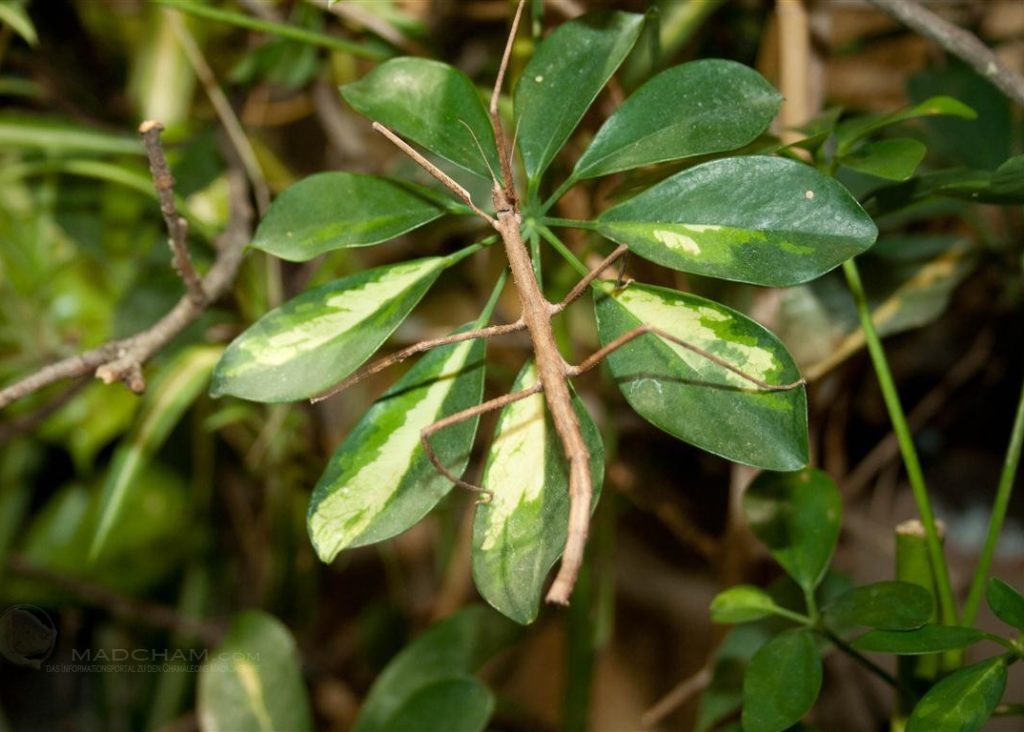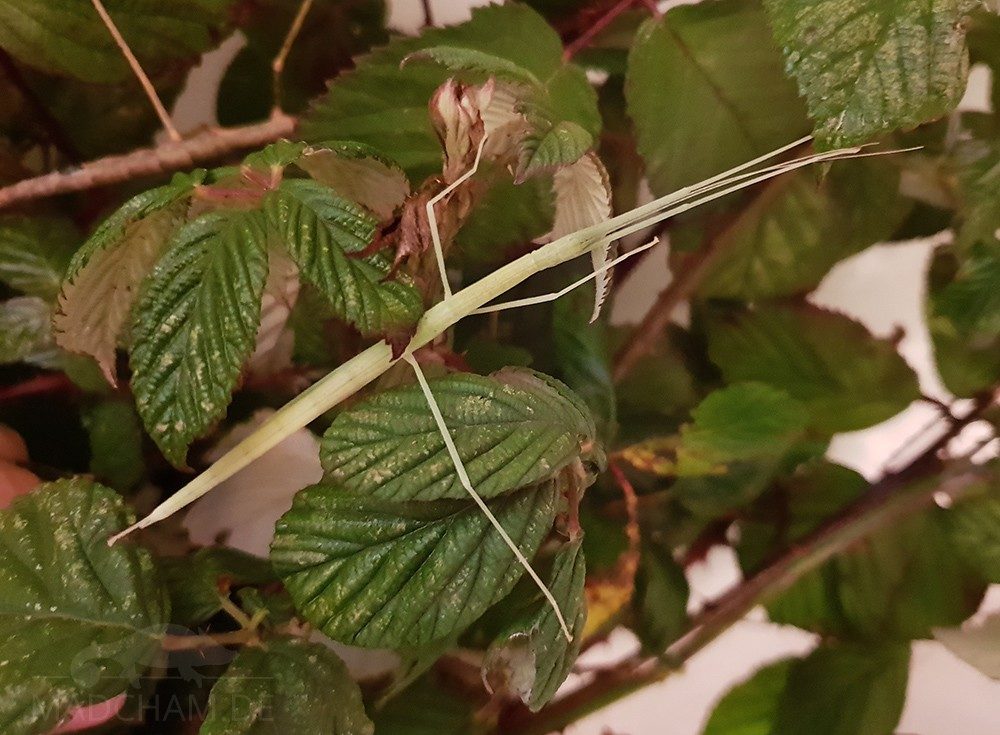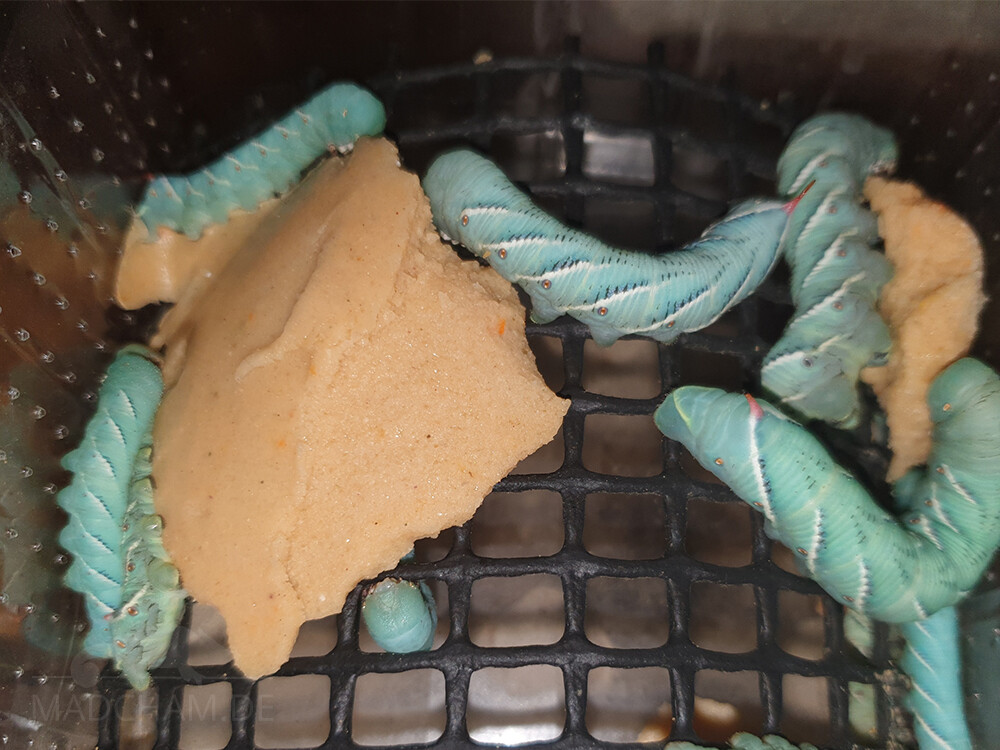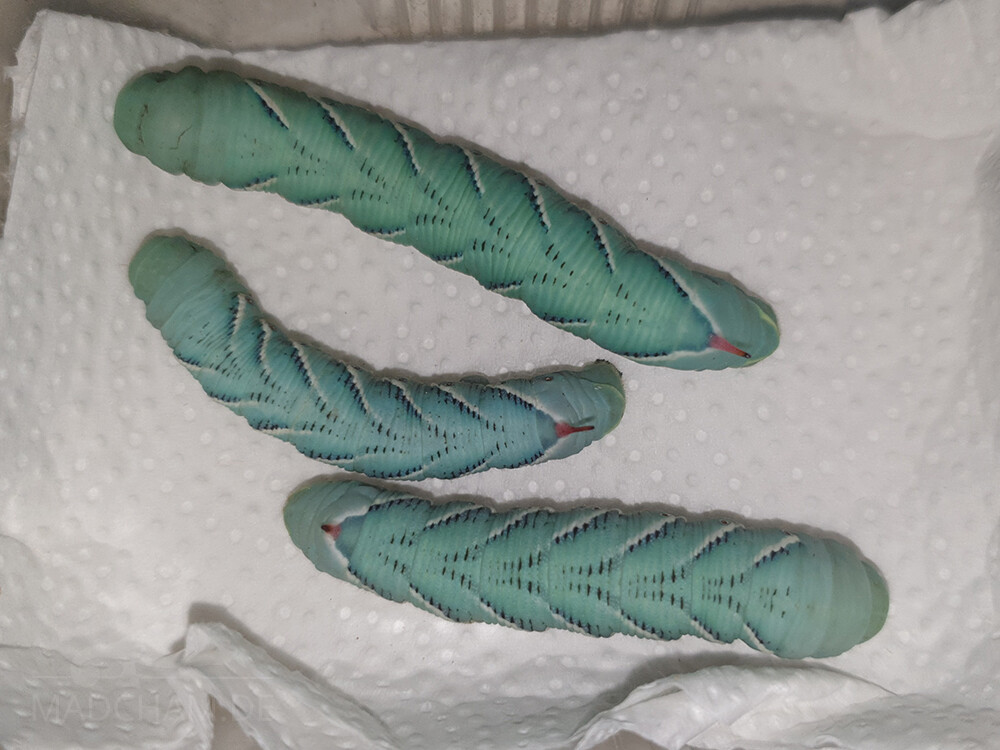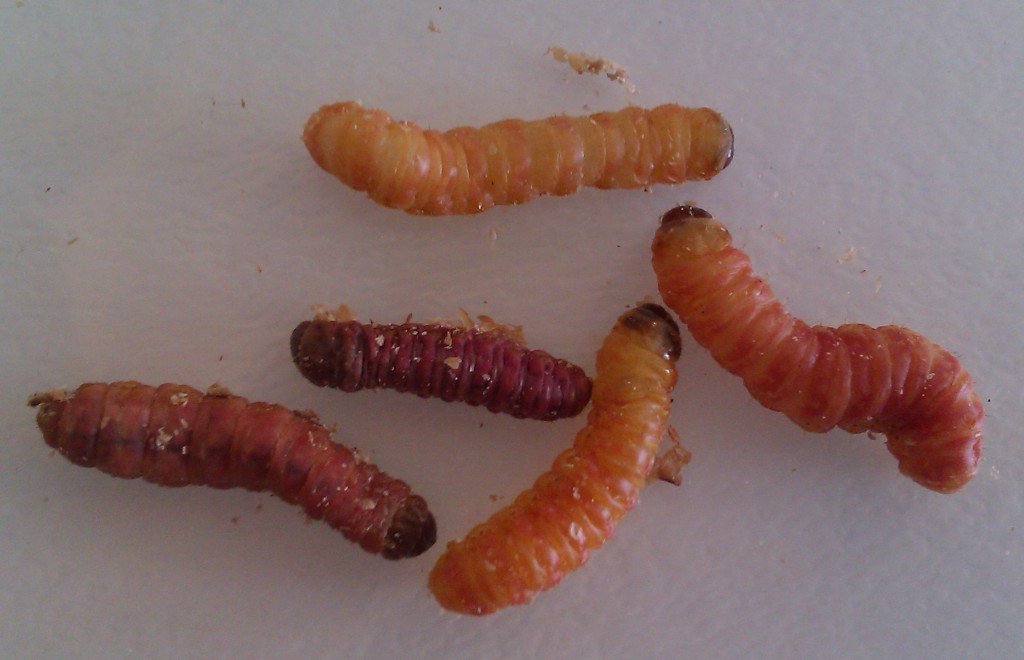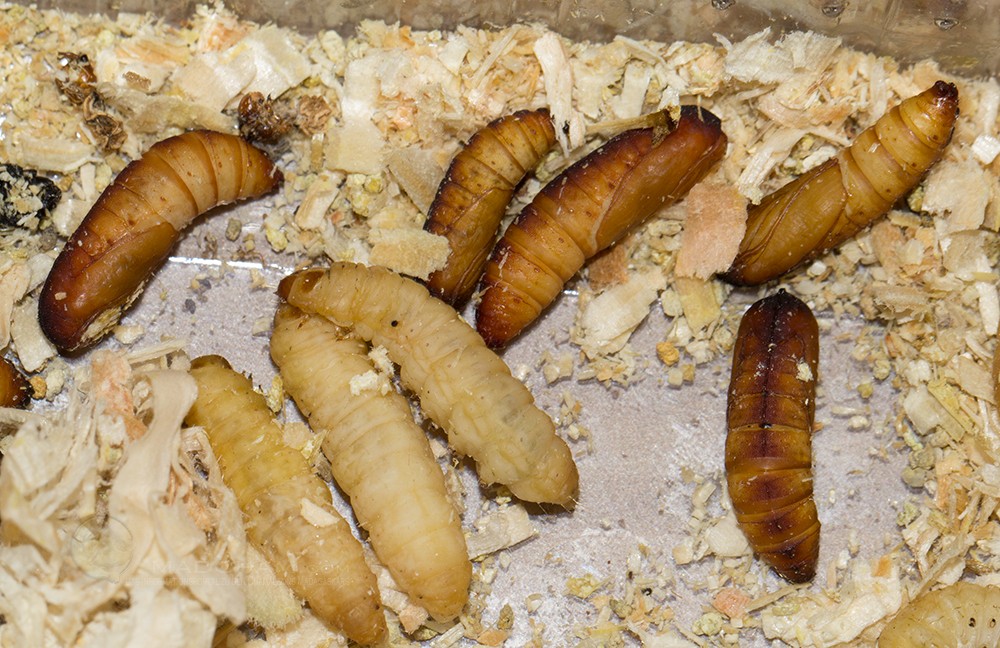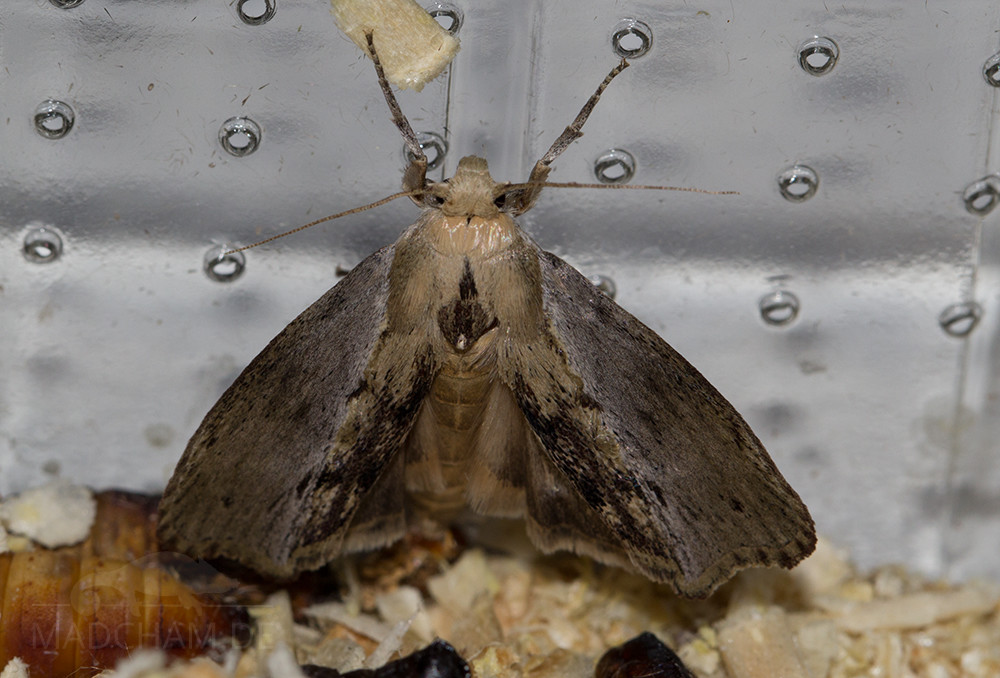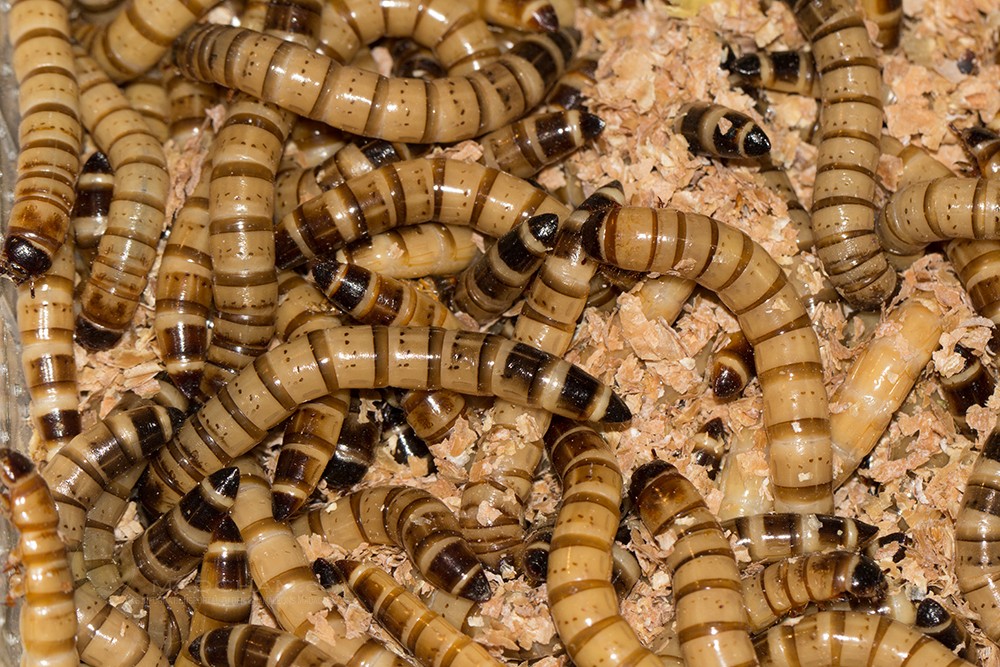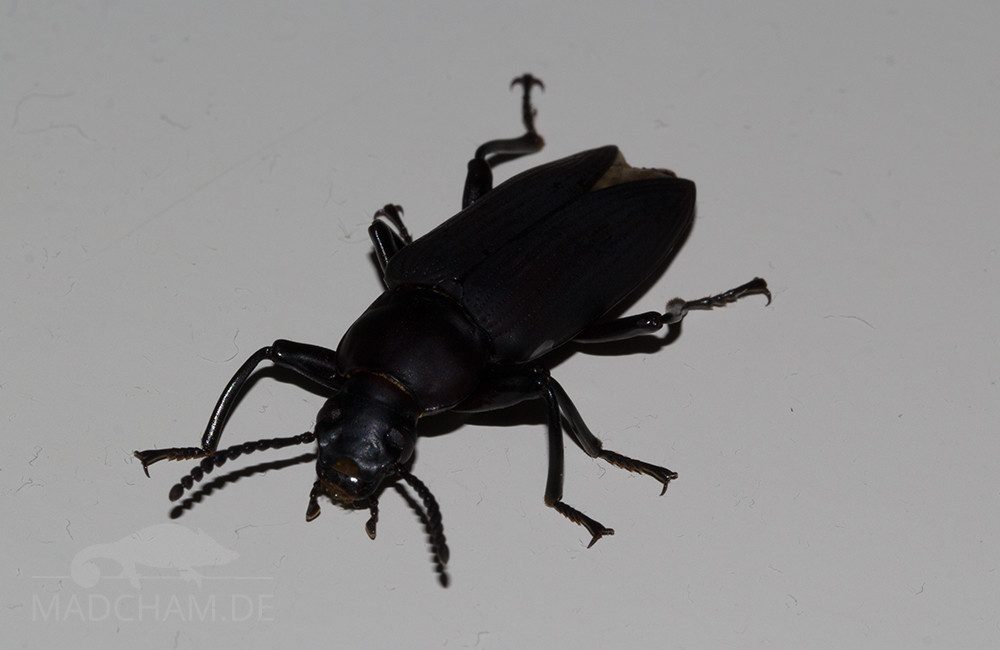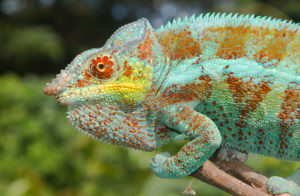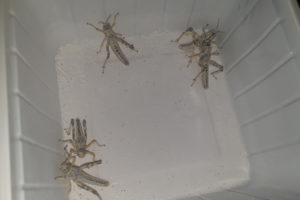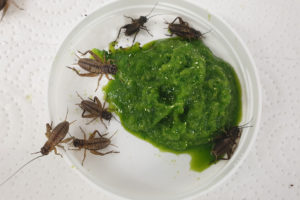Who wants to keep chameleons needs to cope with living feeder insects. Today, pet stores offer a wide variety of potential feeders. This page gives you an overview, tells you which feeders are appropriate for chameleons and which are not.
Generally, insects should always be taken out of the small boxes from the pet store, and get large boxes with ventilation. Egg crates or bark pieces offer space to run. In these boxes, the feeders get fresh food before they end up inside your chameleon. Studies about the contents of feces in Madagascar showed that small and mid-sized chameleons mainly feed on small insects (< 10mm) and many of these are winged. So it is recommendable to use a majority of small feeders in captivity, too. Besides maximally natural feeding, this has the advantage that the chameleon is occupied for a longer time (it needs more time to catch four small insects than to catch one big prey). Bright green colors are very attractive to chameleons, as well as the ability to fly in insects.
Basically, you should only feed insects to your chameleons. Although especially large chameleon species would not disdain one or another small gecko or even sometimes small birds, this should not be part of their diet in captivity. Besides a high danger of overfeeding with all known diseases that follow, reptiles and mammals as feeders imply a high danger of injuries for the chameleon.
All feeders on this page are marked with two colored boxes: These stand for the loudness of the feeder in living rooms (low ![]() , middle
, middle ![]() , high
, high ![]() as well as pest capability in houses (low
as well as pest capability in houses (low ![]() , middle
, middle ![]() , high
, high ![]() .
.
Bean beetles 

(Callosobruchus quadrimaculatus)
Bean beetles are easy to breed on black-eyed peas and good food for small chameleon species and youngsters. At room temperature, they downright “explode” every few weeks with hundreds of beetles. After some weeks and enough eggs, the beetles die and the boxes stay calm until the next hatching date. Due to their firm shell, some chameleons do not like them. Bean beetles only feed on black-eyed peas. Even if you lose some in your house, they really dislike other beans, dried peas, or similar stuff.
Pea and barley aphids

(Acyrthosiphon pisum, Diuraphis noxia)
These feeders are right for young or very small chameleons, but for those, they are very attractive feeders due to their green color. Similar to Drosophila, they are soft and chameleons love to eat them. Both species can be bred on pea or wheat germ buds. If you have other plants staying next to them, be careful, because they might spread to these plants, too. But if you keep the breeding aphis and those “ready to eat” in high containers with air-permeable tops, you will be safe.
Fruit flies 

(Drosophila melanogaster, Drosophila hydei)
Fruit flies are great feeders for small chameleon species or young chameleons, they are soft and move quickly. Drosophila melanogaster is a little smaller than hydei, and both species are available at shops in a variation that is unable to fly. You just have to know that even in those boxes, there are always some fruit flies flying, too. You can feed fruit flies with fruit puree, very ripe fruits or special mixtures for the larvae (in most cases you already have the latter inside the boxes when buying them). Escaped fruit flies can become quite annoying inside the house, but they are not harmful. To keep all flies inside the cages, a drosophila-dense screen with mesh sizes of 0,8 mm and less has proven to be successful. Additionally, you can put half fruit pieces in the terrarium, and the fruit flies will gather on these.
Composition of Drosophila melanogaster*
| Feeder | Raw protein | Raw fat | Raw fiber | Raw ash | Calcium | Phosphorus | Ca:P-ratio |
| Fly | 70.1 | 12.6 | 27 | 4.5, | 0.1 | 1.05 | 0.1 |
| Larva | 40.3 | 29.4 | 9.8 | 5.9 | 0.59 | 2.3 | 0.26 |
Lesser mealworm beetle
(Alphitobius diaperinus)
You can find the larvae of this beetle as “buffalo worms” in stores, but those are not suitable as regular feeders due to their high protein and fat content. But you can wait the larvae to become pupae and let beetles hatch (may take some weeks), then you get a good chameleon food for smaller species. The reddish beetles should not get into the household’s flour supplies. To prevent larvae and beetles from eating your food, let them stay in high containers with smooth surfaces – they cannot escape from these. Besides flour and bread residues, they also feed on vegetables.
Green bootle fly and the common housefly 

(Lucilia sericata, Musca domestica)
Flies are hardly nutritious, but a great environmental enrichment food for chameleons. Almost all chameleons love to catch flies. The larvae should not be fed, but you can simply leave them at room temperature until they become pupae and the flies hatch. Often, you can obtain cheap pupae in fishing shops, since they cannot use pupaes anymore for fishing. There is no need to feed the flies. Inside the house, escaped flies can become rather annoying. It is helpful to put the box with flies into the freezer for some minutes before feeding your chameleon. Afterward, they move much slower and are easy to “dose”.
Jamaican field crickets 
 , Mediterranean field cricket
, Mediterranean field cricket 
 , and house crickets
, and house crickets 

(Gryllus assimilis, Gryllus bimaculatus, Acheta domestica)
The standard food for most chameleons: Crickets. Chameleons like to eat them, crickets can be easily kept and fed. Mediterranean field crickets might smell strongly sometimes. These and house crickets have extraordinarily loudly chirping males. If you feel disturbed by chirping at night, it would be good to use them as feeders before they reach the adult stage. We recommend using Jamaican field crickets because they are easy to handle, do not chirp very loudly, do not smell, and die fast if escaped into the house. In adults, it is easy to distinguish the genders: Females have an ovipositor, and males do not. You can feed crickets with vegetables, herbs, grasses, pollen, or sometimes even small amounts of dry cat or dog food.
Composition of Acheta domestica*
| Raw protein | Raw fat | Raw fiber | Raw ash | Calcium | Phosphorus | Ca:P-ratio |
| 64.9 | 13.8 | 9.4 | 5.7 | 0.14 | 0.99 | 0.14 |
Locusts 

(Locusta migratoria, Schistocerca gregaria)
The second standard feeder besides crickets, that almost every reptile keeper uses. Full-grown, winged locusts grow up to 8 cm, while freshly hatched locusts are only a few millimeters small. Almost all chameleons love to eat locusts, you just have to take care to offer the appropriate size. Locusts always look for bright places in the cage and do not hide. You can tell migratory locusts from desert locusts by the color of their eyes: the migratory locust has black eyes. You can feed locusts with wheat seedlings, corn leaves, herbs and grasses, hay, and vegetables. They need relatively high temperatures, otherwise, they die quickly.
Composition of Locusta migratoria*
| Raw protein | Raw fat | Raw fiber | Raw ash | Calcium | Phosphorus | Ca:P-ratio |
| 57.3 | 28.3 | 8.5 | 6.6 | 0.13 | 0.11 | 1.18 |
Woodlice 

(Porcellio scaber, Oniscus asellus, Porcellionides pruinosus)
Woodlice are easy to reproduce and a nice variety in the diet of middle-sized chameleons. In small boxes with soil and bark pieces, they breed without any further help. Both species can be found in forests nearby tree trunks, in deadwood, or in the garden in the compost. Accordingly, you can feed them best with vegetables, leaves, and white rotten wood. Some species may taste bitter, so not every chameleon eats woodlice. It depends on the individual animal – you have to try.
Grain weevil

(Sitophilus granarius)
These few mm-sized beetles are suitable for very small chameleons and offspring. Among chameleon keepers, they are not yet very distributed. The adult beetles lay their eggs in grains and after one month, the next generation hatches. You should always keep these beetles in very densely closed boxes because they can easily escape through even the smallest holes. And please don’t store the boxes inside your kitchen, the beetles might become a pest in your flour and other stuff. You can feed them with dried corn, wheat, and other grains.
Mealworm beetles 

(Tenebrio molitor)
Unfortunately, mealworms are very popular feeders, although the larvae should be fed rarely or never to chameleons due to their high-fat content. Instead, you can put the boxes with mealworms inside in a warm place and wait for them to become pupae and finally beetles. This takes some weeks. In a well-working breed, you will almost always have beetles. Those are perfect chameleon feeders for larger chameleons. Always keep the beetles in high boxes with smooth surfaces so they cannot enter your own flour inside your kitchen. To feed mealworms and beetles, you can use grain flour, oatmeal, and vegetables.
Composition of Tenebrio molitor*
| Feeder | Raw protein | Raw fat | Raw fiber | Raw ash | Calcium | Phosphorus | Ca:P-ratio |
| Larva | 52.7 | 32.8 | 5.7 | 3.2 | 0.11 | 0.77 | 0.14 |
| Beetle | 63.7 | 18.4 | 3.1 | 16.1 | 0.07 | 0.78 | 0.09 |
Firebrats 

(Thermobia domestica)
This feeder has been buried in oblivion a little during the last years, but it is a great feeder for young offspring or very small chameleon species, and easy to breed. Firebrats only become one Centimeter in size and prefer living in the dark. That’s why you should always use a cup to feed your chameleons. They move very quickly and chameleons like this behavior. Breeding is easy in tight plastic boxes with egg crates, some cotton wool, and fish flakes. They only need high temperatures to breed. By the way, firebrats are very modest, they would even eat egg crates if you haven’t given food to them.
Silkworms and silk moths

(Bombyx mori)
These pretty silky caterpillars are not often offered and they are rather high priced. Caterpillars and moths can be fed to chameleons from time to time. Often you will not succeed in getting them to pupaes, because the caterpillars eat huge amounts of food per day and are relatively sensitive. Originally, the caterpillars only feed on mulberry leaves. Many breeders developed an artificial food mixture that can also be used and is easier to get.
Composition of Bombyx mori*
| Feeder | Raw protein | Raw fat | Raw fiber | Raw ash | Calcium | Phosphorus | Ca:P-ratio |
| Caterpillar | |||||||
| Pupae | 60.7 | 25.7 | 3.9 | 5.8 | 0.38 | 0.6 | 0.63 |
Dubia roach
 , Death’s head cockroach
, Death’s head cockroach 
 , Kenya roach
, Kenya roach 
 , Turkestan cockroach
, Turkestan cockroach 
 , Unadorned roach
, Unadorned roach 
 , Green banana roach
, Green banana roach 
 , American cockroach
, American cockroach 
 , Madeira cockroach
, Madeira cockroach 

(Blaptica dubia, Blaberus craniifer, Paraplecta minutissima, Shelfordella lateralis, Symploce pallens, Panchlora nivea, Periplaneta americana, Rhyparobia maderae)
Cockroaches often provoke repulsion and disgust but are great feeders. There are many available species with very different pest potentials, so be careful in choosing and handling them. The green banana cockroach (Panchlora nivea) has almost no pest potential and is very attractive for chameleons due to its color and soft body. In return keeping these roaches is a little difficult, they need it warm and humid. Dubia roaches (Blaptica dubia) have low pest potential and are easy to breed even at room temperatures, but have a harder shell and are larger. Paraplecta minutissima from Kenya is a small roach species that is perfect for small and middle-sized chameleons. Madeira cockroaches (Rhypharobia maderae) have a soft shell but are hardly distributed among chameleon keepers. We urgently advise you to avoid buying Turkestan cockroaches (Shelfordella lateralis), death’s head roaches (Blaberus craniifer), or American cockroaches (Periplaneta americana) if you are sensible. These species breed well inside rooms and survive for months without any food, so they have a high pest potential. You can feed all kinds of roaches with vegetables and fruit leftovers, herbs, and bee pollen. The ready-to-feed cockroach food made by QB Insects is also nice.
Composition of various cockroaches*
| Species | Raw protein | Raw fat | Raw fiber | Raw ash | Calcium | Phosphorus | Ca:P-ratio |
| Periplaneta americana | 53.9 | 28.4 | 9.4 | 3.3 | 0.2 | 0.5 | 0.4 |
| Blaptica dubia | 63.0 | 21.4 | 6.4 | 4.9 | 0.2 | 0.5 | 0.4 |
| Blaptica dubia Nymphen |
65.3 | 29.8 | 20.5 | 5.6 | 0.22 | 0.62 | 0.36 |
| Blaptica dubia adult |
96.9 | 13.3 | 15.3 | 6.4 | 0.15 | 0.57 | 0.24 |
| Shelfordella lateralis Nymphen |
55.9 | 38.5 | 27.2 | 4.5 | 0.14 | 0.66 | 0.21 |
| Shelfordella lateralis adult |
77.1 | 17.6 | 16.3 | 5.4 | 0.23 | 0.86 | 0.18 |
Snails
![]()
![]() (Cepaea hortensis, Cepaea nemoralis, Lissachatina fulica)
(Cepaea hortensis, Cepaea nemoralis, Lissachatina fulica)
Small snails may be a nice variety for your larger chameleons’ diet. Due to their house, they are rich in calcium. When collecting snails outside please avoid taking protected species. Lissachatina fulica is a common snail that is easy to breed in captivity. These snails may become very huge, but their offspring can be fed to chameleons without a problem. Due to the hard house, some chameleons do not like to eat snails. Feeder snails should not be bigger than the mouth of the chameleon is wide. You can feed them with vegetables, herbs, and a piece of cuttlefish bone.
Composition of Lissachatina fulica*
| Raw protein | Raw fat | Raw fiber | Raw ash | Calcium | Phosphorus | Ca:P-ratio |
| 39.5 | 1.62 | 43.7 | 21.6 | 0.2 | 108 |
Soldier flies 

(Hermetia illucens)
Soldier flies have become known in the last decade because the maggot, unlike all other larvae, is an excellent feeder. This suitability is due to the unusually good calcium-phosphorus ratio of the larvae. However, their digestibility is not quite as high, so they are not suitable as “nourishing food” for weakened or diseased chameleons. Soldier fly larvae are sometimes sold under the names Phoenix Worms® or Calci Worms®. You can also feed the flies to your chameleon, they move rather slowly and ponderously. There are diverse manuals on how to breed these flies on the internet. You can feed the larvae with poultry feed, oatmeal, bran, and vegetable leftovers.
Composition of Hermetia illucens (Larva)*
| Raw protein | Raw fat | Raw fiber | Raw ash | Calcium | Phosphorus | Ca:P-ratio |
| 42.5 | 28-35 | 0-7 | 15 | 5-5.5 | 0.9-1.5 | 3.3-6.1 |
Stick insects 

(Carausius morosus, Medauroidea extradentata, Ramulus artemis, Sypiloidea sypilus)
Our chameleons really love stick insects. They are easy to keep and breed and lay endless eggs per animal. The species mentioned above can reproduce without males and have rather short reproduction cycles so you can use them well as feeders. Some stick insect species use defense secretion but chameleons seem not to be bothered by the taste. You can feed all species mentioned above with blackberry and raspberry leaves.
Hornworms and tobacco hawkmoths 

(Manduca sexta)
A rather rare and relatively fatty feeder is the caterpillar of the tobacco hawkmoth. As the name suggests, the caterpillars are pests in tobacco plantations and are therefore not allowed to be sold in some countries. In Germany, you can get them from time to time at fairs, but not yet regularly in the pet food trade. In other countries, the caterpillars are known as “hornworms”. The caterpillars can be fed with commercially available food mixtures.
Chilean moths

(Chilecomadia moorei)
These feeders have been imported for years from South America and have become rare during the last years in Europe. The caterpillars are called Butterworms often. They are high in fat content and shouldn’t be used as feeders on a regular basis. The moths are better and more attractive chameleon feeders. Caterpillars feed only on Trevoa trinervis, a Chilean plant.
Wax moths

(Galleria mellonella, Achroea grisella)
Wax moth larvae (in fact these are caterpillars) are high in fat content and should be fed only rarely to chameleons. The larvae pupate quickly at room temperature, so you can use the hatching flying moths for your chameleons. The moths are very appropriate and attractive food. The caterpillars feed on honeycombs. At home, you only have to feed them if you wanted to breed them. So it makes sense to buy well-fed larvae and keep those safe, they can even eat themselves through plastic boxes.
Composition of Galleria melonella (Larva)*
| Raw protein | Raw fat | Raw fiber | Raw ash | Calcium | Phosphorus | Ca:P-ratio |
| 42.4 | 46.4 | 4.8 | 2.7 | 0.11 | 0.62 | 0.18 |
Darkling beetles and superworms

(Zophobas morio)
In contrast to the name super worms or king worms, these larvae are not suitable as regular chameleon food due to their high-fat content. Additionally, these feeders are too large for most chameleon species. If you let them pupate, black beetles will hatch after some weeks or even months. The beetles are fine as chameleon food. You can feed the larvae with fruit and vegetable leftovers, oatmeal, and everything you have left in your kitchen. The urban legend that Zophobas would continue to live in a chameleon’s stomach and eat the chameleon alive from the inside is very questionable. Such reports mostly come from wrongly force-fed weak and sick reptiles with still-alive larvae or grub damage in already dead chameleons.
Composition of Zophobas morio (Larve)*
| Raw protein | Raw fat | Raw fiber | Raw ash | Calcium | Phosphorus | Ca:P-ratio |
| 45.3 | 55.1 | 7.2 | 2.9 | 0.16 | 0.59 | 0.27 |
* Values according to Aboua 1990, Bernard et al. 1997, Kölle 2011, Makkar et al. 2014, Narroso et al. 2014, Finke et al. 2014, Kulma et al. 2016, Cerrata et al. 2021, Boykin et al. 2021
All values in % of dry matter (TM). According to Kölle 2011 and Scott, a calcium-phosphorus ratio of 2:1 should generally be aimed for in the diet of chameleons.

